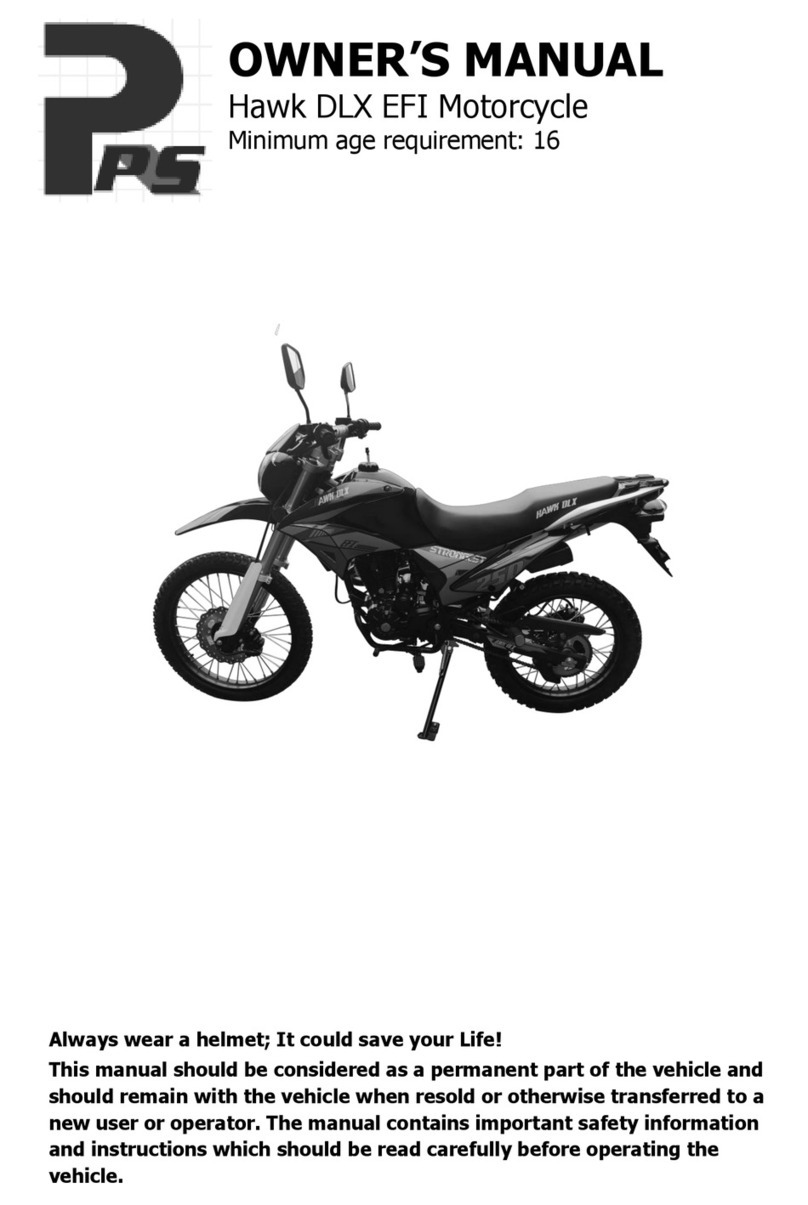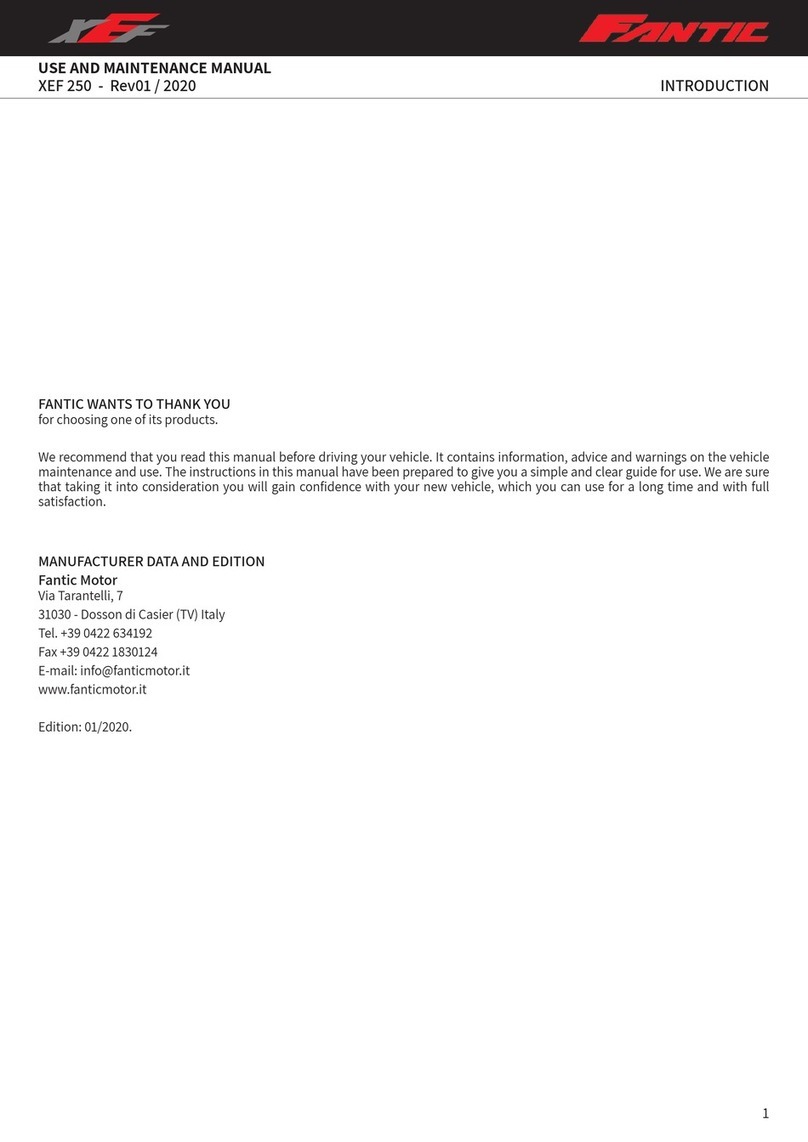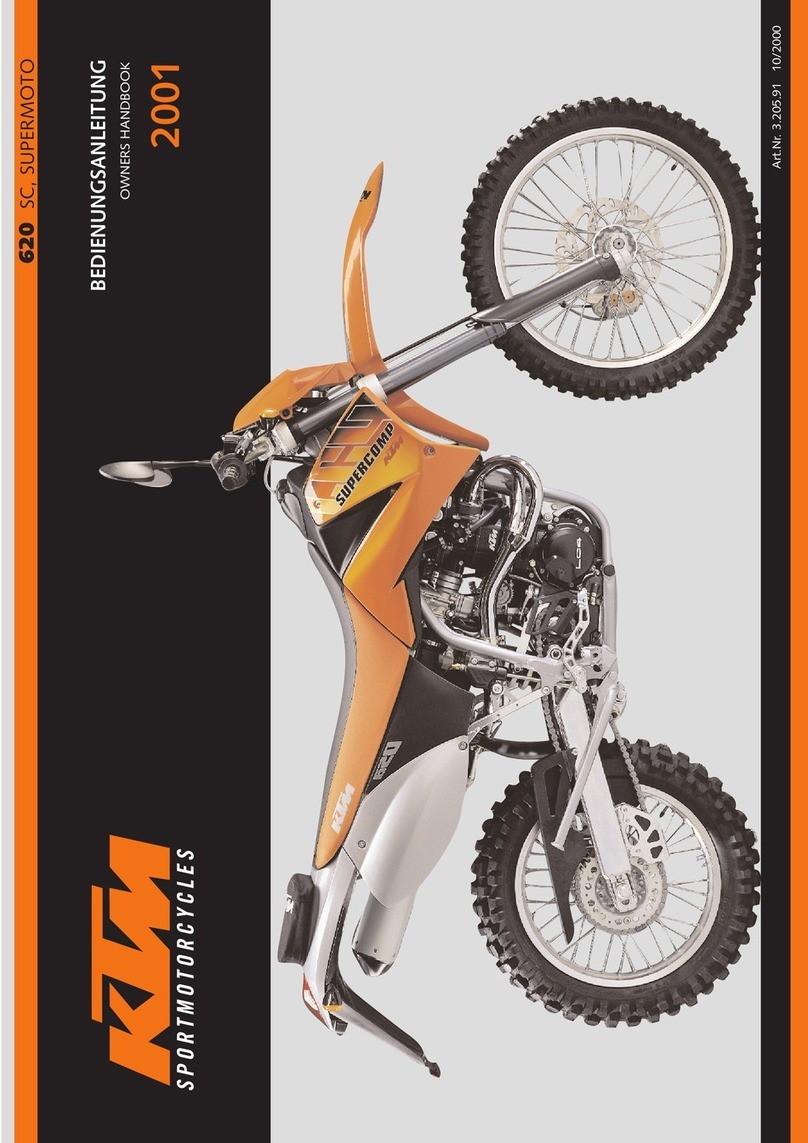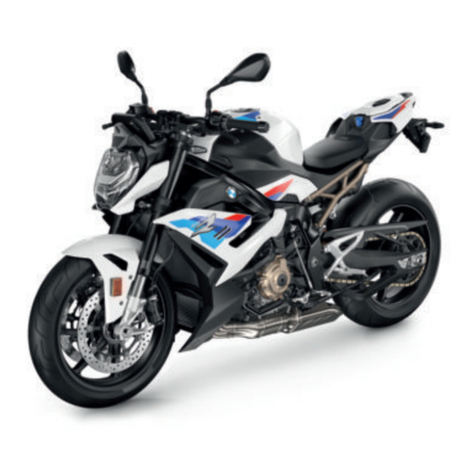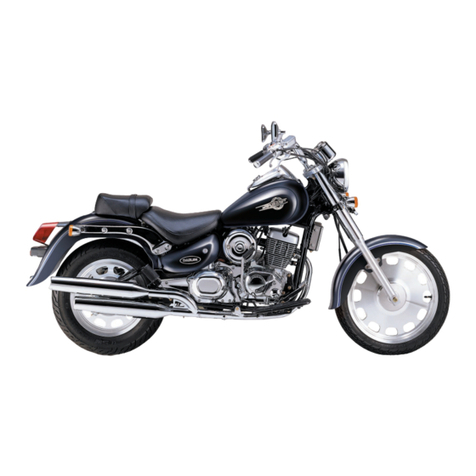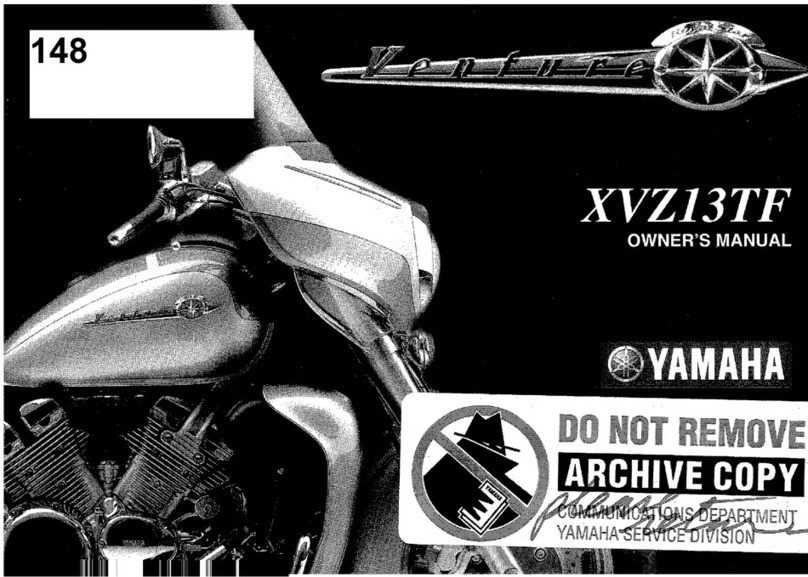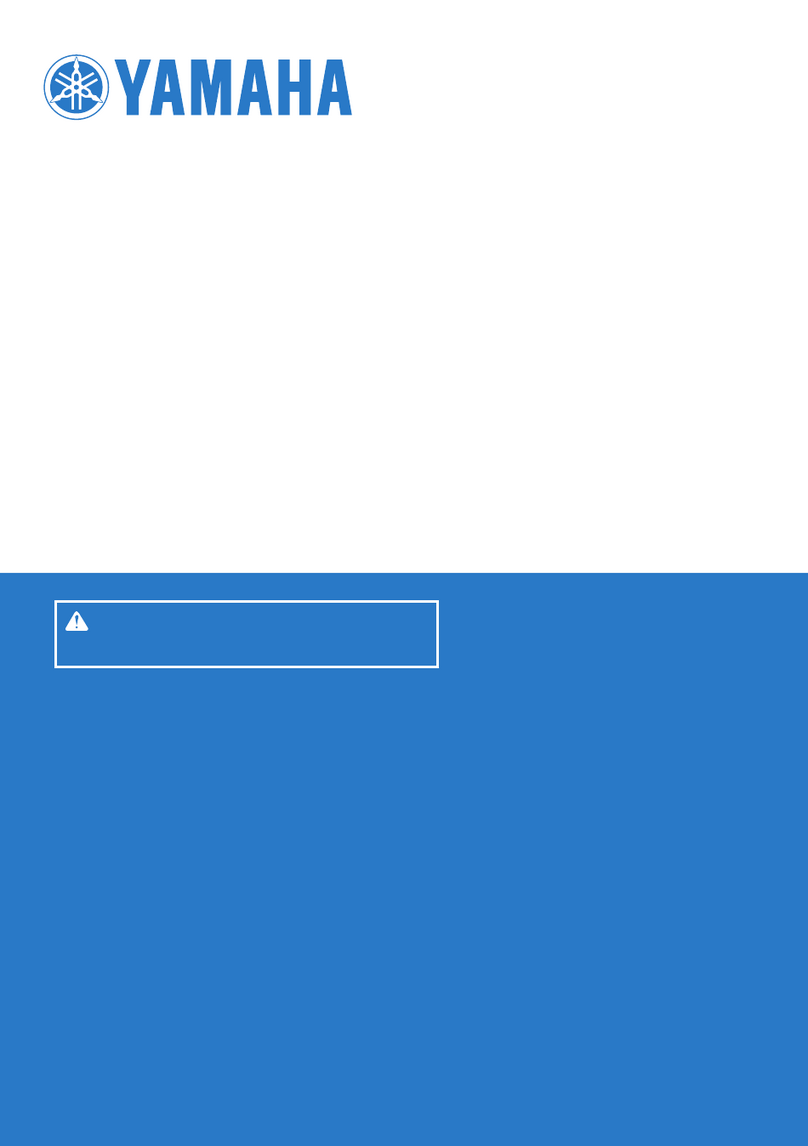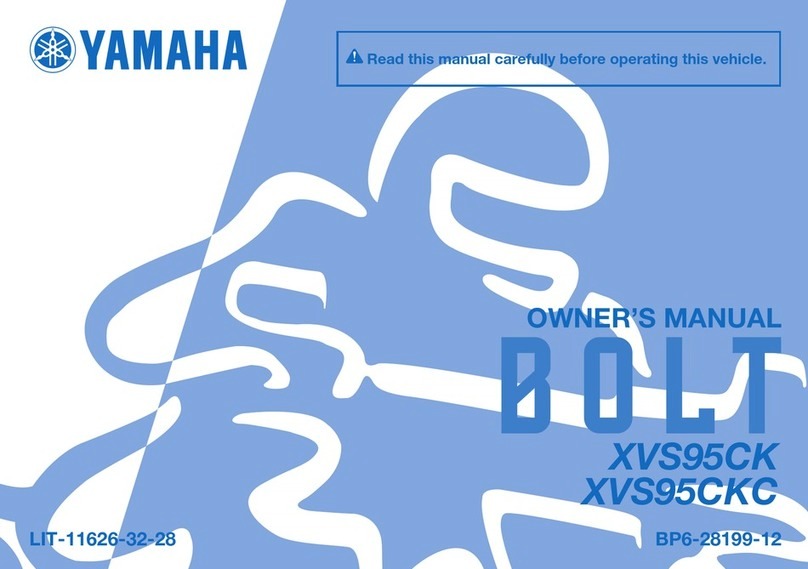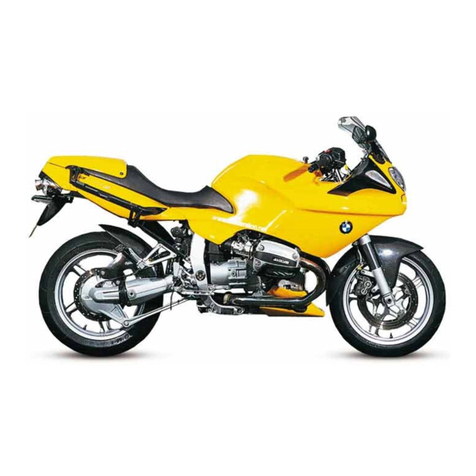PS CONDOR 150 User manual

OWNER’S MANUAL
CONDOR 150
No one under the age of 16 should operate this 150CC motorcycle without adult supervision.
Parents should consider child’s age, size, maturity and ability before allowing to ride.
Always wear a helmet; It could save your Life!
This manual should be considered as a permanent part of the vehicle and should remain with
the vehicle when resold or otherwise transferred to a new user or operator. The manual
contains important safety information and instructions which should be read carefully before
operating the vehicle.
Please obtain, review, and follow the municipal, provincial and government acts and
regulations pertaining to owning and operating an the vehicle.

Congratulations on your purchase of the Ricky Power Sports LLC. CONDOR 150. Your
motorcycle is warranted to be free of manufacturing defects in the material and workmanship
for a period of 90 days from the date of purchase. During the warranty period Ricky Power
Sports LLC. will at its option, repair, provide replacement parts or replace your bike at no
charge. This warranty does not cover normal wear items or damage caused by neglect or
misuse of the product.
Engine Warranty – 90 days
Frame Warranty – 90 days
Warranty is void if:
-Frame is bent or broken due to abuse
-Wheels are bent or broken
-Fender bent or broken due to abuse
-Any sign of impact, accident, jumping, spin-outs or roll over.
Ricky Power Sports LLC. is not liable for any damage claim or liability claim person or
otherwise resulting from the operation of this product in any way.
Should you experience a problem with your vehicle, please call Ricky Power Sports LLC.
customer service line toll free at 1- 844-250-2199. You will be instructed how to proceed.
A COPY OF THE SALES RECEIPT IS REQUIRED.
WARING
This manual should be considered as a permanent part of the vehicle and
should remain with the vehicle when resold or otherwise transferred to a new
user of operator. The manual contains important safety information and
instructions which should be read carefully before operating the vehicle.

1
TABLE OF CONTENTS
NOTICE TO USER’S ........................................................................................................... 2
SAFE OPERATION ............................................................................................................. 3
PRE-RIDE CHECKLIST ....................................................................................................... 3
SAFTY GEAR..................................................................................................................... 4
LOCATION OF WARNING LABLES ...................................................................................... 5
MAIN DATA ...................................................................................................................... 6
PARTS & SUBASSEMBLES .................................................................................................. 7
INDICATORS .................................................................................................................... 7
FUEL VALVE...................................................................................................................... 9
ENGINE STARTING ......................................................................................................... 10
BREAKING IN THE ENGINE.............................................................................................. 11
SWITCHES ON RIGHT HANDLEBAR.................................................................................. 11
GEAR SHIFTING.............................................................................................................. 12
CHECK-UPS, ADJUSTMENT AND MAINTENANCE ............................................................... 13
CHANGING THE OIL,CLEANING OIL FILTER SCREEN ........................................................ 13
CHECK-UP OF SPARK PLUG ............................................................................................. 14
VALVE INSPECTION ........................................................................................................ 14
CHECKING & CLEANING THE AIR FILTER ......................................................................... 15
ADJUSTING THE THROTTLE CABLE ................................................................................. 16
ADJUSTING THE CARBURETOR........................................................................................ 16
INSPECTION OF FRONT HYDRAULIC DISK BRAKE ............................................................ 17
CLUTCH ADJUSTMENT .................................................................................................... 18
ADJUSTMENT OF CHAIN ................................................................................................. 19
GREASING PROCEDURES TO THE DRIVING CHAIN........................................................... 19
TROUBLESHOOTING ....................................................................................................... 20
FUEL SUPPLYING CHECK ................................................................................................. 20
IGNITION SYSTEM CHECK............................................................................................... 21
VEHICLE WASHING......................................................................................................... 22
INSTRUCTIONS FOR STORAGE........................................................................................ 23
RESUMPTION OF SERVICE AFTER STORAGE .................................................................... 24
TABLE OF TORQUE OF FASTENERS ................................................................................. 24
RESUMPTION OF SERVICE .............................................................................................. 24
INSPECTION AND MAINTENANCE .................................................................................... 24
MAINTENANCE SCHEDULE .............................................................................................. 25
SERIAL NUMBER LOCATION ............................................................................................ 26
WIRE DIAGRAM .............................................................................................................. 26
HMC-EMISSION CONTROL SYSTEM WARRANTY STATEMENT ............................................ 28

2
NOTICE TO USER’S
Please read this manual and follow all instructions carefully. To emphasize
special information, the symbol and the words WARNING or CAUTION have some special meanings.
Pay great attention to the messages.
WARING
Indicates a potential hazard that could result in death or injury.
CAUTION
Indicates a potential hazard that could result in vehicle damage.
NOTE: Indicating special information which is to make maintenance easier or instructions
clearer.
WARNING and CAUTION are arranged like this:
WARING-OR-CAUTION
The first part will identify a POTENTIAL HAZARD.
The second part will describe WHAT COULD HAPPEN if you ignore the WARING or CAUTION.
The third part will describe HOW TO AVOID THE HAZARD.
This user’s manual contains important safety and maintenance information.
Read it carefully before riding. Failing to follow the warnings contained in this manual could result in INJURY
or DEATH.
It is important that this manual remain with the vehicle when you transfer it to another user or owner.
All information, illustrations, photographs and specifications contained in this manual are based on the latest
product information available at the time of publication. Due to improvements or other changes, there will
be some discrepancies in this manual. We reserve the right to make product changes at any time, without
notice and without incurring any obligation to make the same or similar changes to the vehicle previously
built or sold.

3
SAFE OPERATION
A pre-operation check must be conducted before starting the engine.
This check will insure safety, prevent mishaps, and prevent damage to components.
It is strongly suggested that all operators take a certified motorcycle rider’s course prior to operating the
vehicle.
Full attention is required during driving; paying close attention to the following points to avoid any injury to
you by other motorized vehicles:
•Do not drive too close to other vehicles.
•This motorcycle is for one operator only.
•Driving at high speeds is the cause of many accidents; do not drive at a speed that the actual situation
does not permit.
PRE-RIDE CHECKLIST
1. Engine oil level
a) Check for leaks
b) Tighten filler cap securely.
c) Add oil if required.
2. Fuel level
a) Add fuel as necessary.
b) Do not overfill (no fuel in the filler neck).
c) Do not mix oil with gas.
d) Replace cap tightly.
e) Do not refuel a hot engine. Allow engine to cool before adding fuel.
3. Warning decals
a) Make sure all warning decals are legible and securely attached.
b) Replace as necessary.
4. Tires
a) Ensure that both tires are in safe riding condition.
b) Properly inflate both tires. We recommend that you inflate the tire to between 15psi and 20osi. Do not
exceed 32 psi.
5. Drive chain
a) Check condition and tension.
b) Lubricate and adjust tension as necessary.
6. Throttle
a) Check for smooth operation. Make sure the throttle “snaps” back to idle.

4
b) Check for frayed cable or damaged cable housing. Replace damaged cable.
c) Check for mud, debris and ice in the throttle cable/mechanism.
Clean out any contamination.
SAFTY GEAR
A DOT approved motorcycle helmet is the most important part of you safety gear. A DOT approved
motorcycle helmet can help prevent a serious head injury. Choose a helmet that fits snugly. Motorcycle
dealers can help in selecting a good quality helmet which fits properly.
WARING
Operating this motorcycle without wearing an approved DOT motorcycle helmet, eye protection, and
protective clothing could be hazardous.
Operating without an approved DOT motorcycle helmet or eye protection increases your chances of a
severe head injury or death in an accident. Operating without protective clothing also increases your
chances of sever injury in an accident.
Always wear an approved DOT motorcycle helmet which fits properly. Always wear eye protection
(goggles or face shield). You should also wear gloves, boots, long sleeve shirt or jacket, and long
pants.
You should wear eye protection when you ride. If a rock or a branch hits your eyes, you could be severely
injured. Wear goggles or a face shield.
Wear proper clothing when you ride. The proper clothes can protect you from injury. Wear a good pair of
gloves, strong boots that are over the ankle, long pants, and a long sleeve shirt.

5
LOCATION OF WARNING LABLES
Read and follow all of the warnings labels on your motorcycle. Make sure you understand all the labels. Keep
the labels on the motorcycle. Do not remove them for any reason. If a label come off or become difficult to
read, you should get a replacement by contacting Ricky Power Sports LLC or your dealer.

6
MAIN DATA
DESCRIPTION DATA DESCRIPTION DATA
Overall length 1775mm Cylinder bore * Stroke 62*49.5mm
Overall width 770mm Compression ratio 9.0:1
Overall height 1025mm Related power 8.2Kw/8500rpm
Seat height 795mm Related torque 10.0N.m/7000rpm
Wheelbase 1220mm Idle speed 1500±150 rpm
Curb Mass 106Kg Displacement 149ml
Payload 150Kg Spark plug DR8EA(Torch)
Gap:0.6~0.8mm
Ground clearance 165mm Front wheel 120/70-12
Max speed 87Km/h Rear wheel 130/70-12
Transmission 5Gea Ignition means C.D.I.
Capacity of fuel tank 6.4L
Brake
Front: Disc
Oil capacity 1.1L Rear: Disc
Lubrication method Pressure, splash Sprocket 428H-106
Clutch Manual / Wet Battery 12N7L-4B

7
PARTS & SUBASSEMBLES

8
INDICATORS
The indicators on your motorcycle help make you aware of possible issues, refer to them often.
Speedometer - Shows the speed you are traveling miles per hour.
Odometer - Tracks the total miles driven.
Trip meter - Tracks the total miles driven on your trip.
High beam indicator - Illuminates when high beam lights are on.
Turn signal indicator - Flashes when left/right turn signal is on.
Neutral indicator - Illuminates when transmission is in neutral.
Setup button – Set the vehicle instrument to display TOTAL or TRIP. In trip state, press and hold to clear.

9
FUEL VALVE
Fuel filling
The capacity of the fuel tank is 6.4L. Unscrew the gas cap by turning it counter clockwise and carefully fill
the tank with unleaded gasoline through the opening. DO NOT MIX GAS AND OIL TOGETHER, THIS IS A 4-
STROKE ENGINE. Replace the gas cap by carefully aligning the threads on the cap and the tank and turning
the cap clock wise. Wipe any spilled fuel from the dirt bike using a cloth and dispose of the cloth properly.
DO NOT SMOKE OR REFUEL THE VEHICLE NEAR OPEN FLAMES OR NEAR HEATING UNITS.
ONLY REFUEL THE VEHICLE IN OPEN AREAS TO REDUCE THE LIKELIHOOD OF THE BUILD UP OF
GASOLINE FUMES.
Operation of the fuel valve (the valve under the fuel tank)
ON: With the handle of the fuel valve at “ON” position, the fuel supply will flow to the carburetor.
OFF: With the handle of the fuel valve at “OFF” position, the fuel supply will not flow to the carburetor.
RES: If fuel level in the fuel tank becomes too low for engine to stay running while fuel valve is at “ON”
position, turn fuel valve to “RESERVE”. Turning fuel valve to “RESERVE” will allow engine to begin using
reserve fuel supply.
You will need to re-fuel as soon as possible. There is approximately 1L of fuel left in tank when fuel valve is
placed at “RESERVE”. Once re-fueled, turn fuel valve back to the “ON “ Position

10
ENGINE STARTING
CAUTION
Verify oil level prior to starting.
Starting the engine with low or no oil will damage the engine.
WARING
Never start the engine in a closed place as the exhausted gas from the vehicle contains toxic carbon
monoxide.
Set the key of the ignition switch to position.
1. Put the motorcycle in the neutral gear.
2. Ensure that there is fuel in the tank.
3. Set the fuel valve handle to “ON” or “RES” position.
To start a cold engine:
1. Pull up the choke lever of the carburetor (to open the choke).
2. Start the engine with start button or kick starter.
3. Slightly turn the throttle twist grip to increase the speed of the engine so as to warm up the engine.
4. Turn the carburetor choke bar downward to fully close the choke when the engine is sufficiently warmed
up.
CAUTION
Unnecessarily increasing RPM’s to a high level while the motorcycle is in neutral is harmful to the
engine.
Procedures for stopping the engine:
1. Release the throttle twist grip to slow down the engine.
2. Shift to the neutral position.
3. Set the ignition switch key to position.
4. Set the fuel valve handle to “OFF” position.

11
BREAKING IN THE ENGINE
The first 30~50 Miles of operation should be considered the “Break-in” period and special attention shall be
paid to the following points:
1. Take special care not to increase the RPM’s of the engine while climbing steep slopes. Never drive your
motorcycle continuously for more than 50km (30 miles) without increasing and decreasing the throttle.
2. The engine shall be warmed up for 3-5 minutes prior to operation so all components are lubricated
sufficiently.
3. The driving speed shall not be over 40 kmph (25 MPH) maximum during the first 500 km (300 miles) of
operation and not over 65 kmph (40 MPH) maximum during the remaining 500 km (300 miles) of the
“Break-In” period.
SWITCHES ON RIGHT HANDLEBAR
Ignition switch
The ignition switch is Located on the right handlebar.
When the switch is turned to (off) position, the engine will not start. If the engine is running and the
Off button is pushed the engine will turn off.
When the switch is turned to (on) position, the engine can start by using the electric start or kick
start lever.

12
GEAR SHIFTING
Reduce throttle before shifting. Never increase the throttle while
shifting gears.
Pull in the clutch lever, located on the left hand grip.
Depress the Shift lever to place the gear in 1st, lift up the lever to shift
to 2nd, 3rd, 4th and 5th.
Do not place your foot on the gear-shifting pedal while operating the
motorcycle to avoid clutch damage caused by accidental gear shifting.
Shifting sequence
(1) 1st gear
(N) Neutral
(2) 2nd gear
(3) 3rd gear
(4) 4th gear
(5) 5th gear
Points for Attention during Drive
1. To warm the engine let engine idle. Do not rev the engine to prevent damage to the engine components.
2. The clutch will wear out quickly if the motorcycle is operated with the clutch in a semi-engaged position.
3. Shift to the low speed gears when you feel that there is insufficient power to climb hills or continue
forward.
4. Do not use the front brake only or coast using the neutral gear especially when descending or driving at
a high speed.
5. Decrease the throttle when braking.

13
CHECK-UPS, ADJUSTMENT AND MAINTENANCE
Checking the Oil
Check the engine oil each time prior to operating the motorcycle.
The oil level should be between the upper and lower lines of the oil sight
gauge located on the right cover of the crankcase. The level can also be
checked on the dip stick.
1. Set the motorcycle on level ground, look at the sight gauge for current
oil level. Remove the oil gage plug, wipe the oil gage rod clean and then
insert the gage plug into the crankcase again to check the oil level.
There is no need to completely install the oil gage plug in the crankcase
fill hole.
2. Add lubricating oil up to the upper line when needed, but do not overfill.
3. Finally screw on the oil gage plug tightly.
CAUTION
Never start the engine when there is insufficient lubricating oil. Otherwise, it will cause harm to the
engine.
Lubricating Oil Recommended
The lubricating oil is an important factor affecting
the performance and service life of the engine.
Please refer to the chart for the correct grade of
engine oil based on the environmental conditions
in your area. Do not use any other type of oil other
than what is recommended in the chart. DO NOT
MIX OIL WITH THE GASOLINE.
Lubricating oils of different viscosity shall be
employed in different regions and at different
temperatures.
CHANGING THE OIL,CLEANING OIL FILTER SCREEN
1. of the engine and let the oil drain into an approved collection container.
DO NOT PERFORM THIS PROCEDURE WHILE THE ENGINE IS HOT.
SERIOUS BURNS COULD RESULT FROM CONTACT WITH HOT
OIL.
2. Dispose of the used oil properly. For proper disposal
procedures, contact your local oil recycling center.
3. Clean oil screen and spring with solvent.
4. Clean and replace the oil drain plug making sure it is secure.
Oil in the engine by using the oil gauge plug and/or sight gauge.

14
CHECK-UP OF SPARK PLUG
1. Remove the cap of spark plug and screw off the spark plug using
the plug wrench.
2. Clean the spark plug all around or replace it if it is corroded or
there is too much deposit on it.
3. Regulate the gap of the spark plug to 0.6-0.8mm. (.024 inches -
.032 inches)
The spark plug of the designated type should be used. The applicable
type of spark plug: DR8EA (Torch) or equivalent
VALVE INSPECTION
Refer to maintenance schedule in this owner’s manual for valve adjustment inspection intervals .
Valve clearance should be:
Intake: 0.02-0.03mm
Exhaust: 0.03-0.05mm
The engine will make excess noise if the gap is too large in air valve. If gap is too small valve operation will
be hindered which could result in valve malfunction and failure. Therefore, air valve gap must be checked
periodically.
If you have the proper tools and are mechanically proficient, instructions on adjusting the valve clearance
are given in the service manual. If assistance is needed please contact dealer to find your local service
center.

15
CHECKING & CLEANING THE AIR FILTER
Air filter is located under left side plastic cowling. Cowling will need to be removed.
Take the air filter out and check to see if it is dirty or torn.
Remove foam element and wash with water and allow it to dry per instructions below.
Apply a few drops of machine oil. Squeeze it with a dry cloth to remove excess oil.
Recommended oil:
SAE 15W-40
CAUTION
The air filter element must be intact or the engine will suck in dust and dirt, resulting in a shorter
service life of the engine.
Water should be prevented from entering into the filter when washing the vehicle.
The filter element shall be cleaned gently without twisting to prevent it form cracking. Never wash it
with gasoline or and acid, alkaline or organic volatile oil to avoid its aging, which will result in reducing
the effect of the air filter oil to catch particles before they enter the engine. Replace the filter element
with a new one if it is broken or cracked.

16
ADJUSTING THE THROTTLE CABLE
Make sure the throttle works normally.
Check if the throttle twist grip has the required free operating
movement.
The required free operating movement: 2-6mm (0.078 inches - 0.24
inches) If the grip cannot be moved freely, turn the adjusting nut
located near the throttle twist grip to ensure proper operating
movement.
After adjustment, start the engine and check for the operating
movement again. Repeat the adjustment if necessary until the desired operating movement is obtained.
ADJUSTING THE CARBURETOR
Adjusting procedures of idling speed:
1. Support the vehicle by a stand.
2. Adjust the idling speed by the special designed tool to 1500 ± 150r/min.
CAUTION
Do not try to correct a malfunction carburetor by adjusting the idling speed. If the carburetor is not
functioning properly, it should be repaired by dealer.
Adjust idling speed only when the engine is warmed up or 10 minutes after operation.

17
INSPECTION OF FRONT HYDRAULIC DISK BRAKE
1. Inspect the front disk brake caliper for leakage. If brake fluid leaks, the safety of riding could be affected.
2. Inspect the brake hose for cracks, and the joint for leakage.
3. Check the brake fluid level in the brake fluid reservoir, if level is at or below the LOWER mark, inspect
brake pads for wear and hydraulic system for leaks.
4. To add brake fluid, unscrew the 2 screws on top of the bake fluid container. Add DOT3 or DOT4 brake
fluid. Do not mix brake fluid types.
FRONT HYDRAULIC DISK BRAKE INSPECTION REAR HYDRAULIC DISK BRAKE INSPECTION
1. Inspect the rear disk brake caliper for leakage. If brake fluid leaks, the safety of riding could be affected.
2. Inspect the brake hose for cracks, and the joint for leakage.
3. Check the brake fluid level in the brake fluid reservoir, if level is at or below the LOWER mark, inspect
brake pads for wear and hydraulic system for leaks.
4. To add brake fluid, unscrew cap on top of brake fluid container. Add DOT3 or DOT4 brake fluid. Do not
mix brake fluid types.

18
CLUTCH ADJUSTMENT
To adjust the clutch lever play:
1. Remove the adjuster cover (slide back on cable).
2. Loosen adjuster nut and move adjuster in or out to obtain the
correct play.
3. Tighten adjuster nut
4. Recheck the clutch lever free distance.
Readjust it if it is not within the correct limits.
To adjust the clutch:
1. Loosen adjuster nut and move adjuster in or out to obtain the correct tension.
2. Tighten adjuster nut
3. Recheck the clutch lever free distance.
Readjust it if it is not within the correct limits.
Table of contents
Other PS Motorcycle manuals
